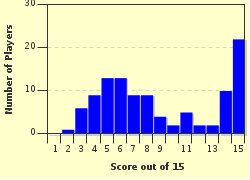Quiz Answer Key and Fun Facts
1. Kenneth MacAlpin was the first King of Scotland.
2. How long did Constantine II, grandson of Kenneth MacAplin, reign?
3. The Battle of Carham occured during which King's reign?
4. When did Macbeth reign?
5. Who was Malcolm 'Canmore' III's second wife?
6. Where is David I buried?
7. Malcolm IV was nicknamed "The Maiden" because he was considered weak and effeminate.
8. Why was William I given the nickname "the Lion"?
9. Alexander II, son of William the Lion, died in 1249. What age was his heir, Alexander III?
10. Alexander III died after falling from his horse at Kinghorn in 1286. His only living heir, a granddaughter called Margaret, died on the crossing to Scotland. Who was chosen to replace her by Edward I of England?
11. William Wallace has gone down in history as one of Scotland's most celebrated heroes. He was never king, but in which year was he awarded the title Guardian of Scotland?
12. Who crowned Robert the Bruce (grandson of the original claimant) at Scone on the 25th March 1306, barely a month after he killed his rival, John Comyn?
13. On what days in 1314 did the Battle of Bannockburn happen?
14. David II, son of Robert the Bruce, married which King's sister?
15. David II died in 1371 without producing any heirs. The crown went instead to David's nephew, Robert II. What was the name of this new dynasty that would rule in Scotland for almost 230 years?
Source: Author
ScottishGal
This quiz was reviewed by FunTrivia editor
bloomsby before going online.
Any errors found in FunTrivia content are routinely corrected through our feedback system.

